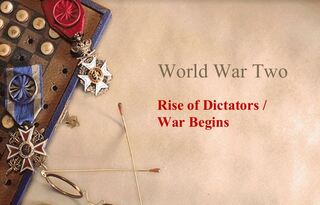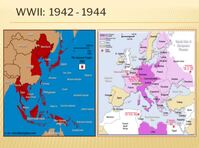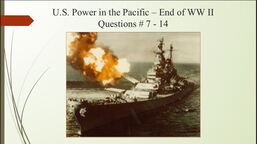Instructions
Guided Notes
PowerPoint and Textbook - Chapter 21
Key Figures from WWII
1) Fascist leader of Italy –
2) Led Nazis in Germany –
3) Totalitarian dictator of the Soviet Union –
4) Militarist Prime Minister of Japan –
5) British Prime Minister (1940) –
6) Commander of U.S. Pacific Fleet –
7) General who vowed “I shall return,” after being forced from the Philippines –
8) Commander of U.S. forces in North Africa/Europe –
9) Lead scientist of secret U.S. plan to build an atomic bomb –
10) U.S. president who took office after the death of FDR & ordered nuclear strikes on Japan –
Neutrality to War – America Joins the Allies
11) Name the three acts of legislation that brought America closer to war from 1939 – 1941 –
12) Name the three countries that composed the Axis Powers in WW II –
13) What were the two main reasons Japan attacked Pearl Harbor in December 1941?
14) Why was the above-referenced attack not a complete success for the Japanese?
15) What was the Atlantic Charter?
WWII: 1942 – 1944
16) Who led the first bombing raid over Japan in April 1942?
17) Why was the Battle of Midway a turning point in the Pacific Theatre?
18) Operation Torch
a) Where did this take place?
b) What important canal was secured via the British victory at El Alamein?
c) What happened on May 13, 1943 in Tunisia?
19) Battle of the Atlantic
a) What system did the U.S. navy employ to safely conduct ships across the ocean?
b) Name three new technological innovations used by the Americans to combat
German submarines –
c) How were depth charges effective against enemy submarines?
20) What city was captured by the Allies in 1944 after bloody fighting at Anzio?
End of the War in Europe
21) What was the name of the Allied invasion of Nazi-controlled France?
22) What happened at the Battle of the Bulge?
23) What was V-E Day?
U.S. Power in the Pacific/End of WWII
24) What was the name of the U.S. strategy in the Pacific?
25) What was the significance of the capture of Iwo Jima by U.S. forces?
26) What was the codename for the secret U.S. program to build an atomic weapon?
27) What was the major argument for NOT invading Japan and, instead, dropping nuclear weapons on Hiroshima and Nagasaki to quickly end the War?
- Using the two PowerPoint PDFs below and/or the textbook, complete the Guided Notes questions below.
Guided Notes
PowerPoint and Textbook - Chapter 21
Key Figures from WWII
1) Fascist leader of Italy –
2) Led Nazis in Germany –
3) Totalitarian dictator of the Soviet Union –
4) Militarist Prime Minister of Japan –
5) British Prime Minister (1940) –
6) Commander of U.S. Pacific Fleet –
7) General who vowed “I shall return,” after being forced from the Philippines –
8) Commander of U.S. forces in North Africa/Europe –
9) Lead scientist of secret U.S. plan to build an atomic bomb –
10) U.S. president who took office after the death of FDR & ordered nuclear strikes on Japan –
Neutrality to War – America Joins the Allies
11) Name the three acts of legislation that brought America closer to war from 1939 – 1941 –
12) Name the three countries that composed the Axis Powers in WW II –
13) What were the two main reasons Japan attacked Pearl Harbor in December 1941?
14) Why was the above-referenced attack not a complete success for the Japanese?
15) What was the Atlantic Charter?
WWII: 1942 – 1944
16) Who led the first bombing raid over Japan in April 1942?
17) Why was the Battle of Midway a turning point in the Pacific Theatre?
18) Operation Torch
a) Where did this take place?
b) What important canal was secured via the British victory at El Alamein?
c) What happened on May 13, 1943 in Tunisia?
19) Battle of the Atlantic
a) What system did the U.S. navy employ to safely conduct ships across the ocean?
b) Name three new technological innovations used by the Americans to combat
German submarines –
c) How were depth charges effective against enemy submarines?
20) What city was captured by the Allies in 1944 after bloody fighting at Anzio?
End of the War in Europe
21) What was the name of the Allied invasion of Nazi-controlled France?
22) What happened at the Battle of the Bulge?
23) What was V-E Day?
U.S. Power in the Pacific/End of WWII
24) What was the name of the U.S. strategy in the Pacific?
25) What was the significance of the capture of Iwo Jima by U.S. forces?
26) What was the codename for the secret U.S. program to build an atomic weapon?
27) What was the major argument for NOT invading Japan and, instead, dropping nuclear weapons on Hiroshima and Nagasaki to quickly end the War?




